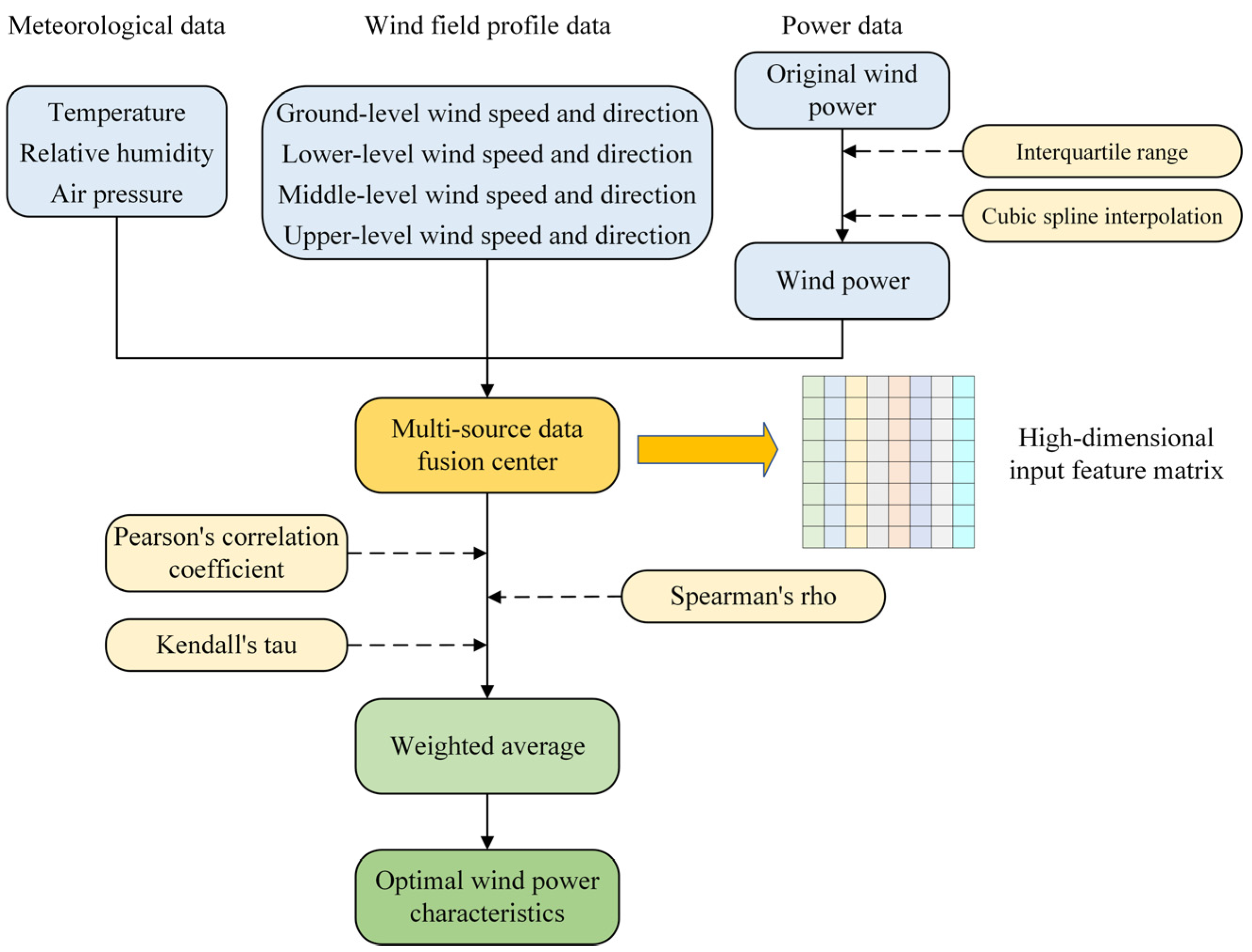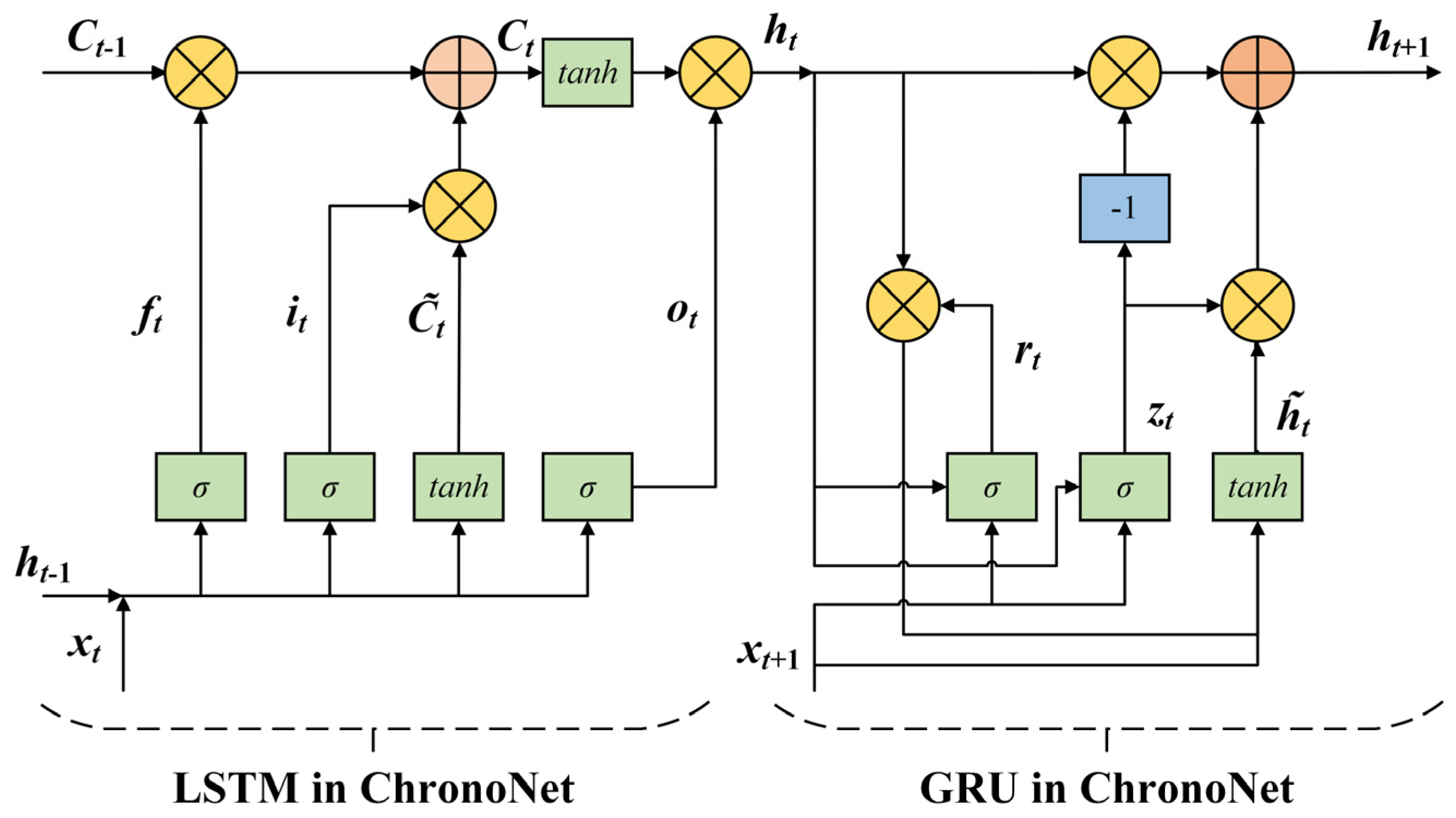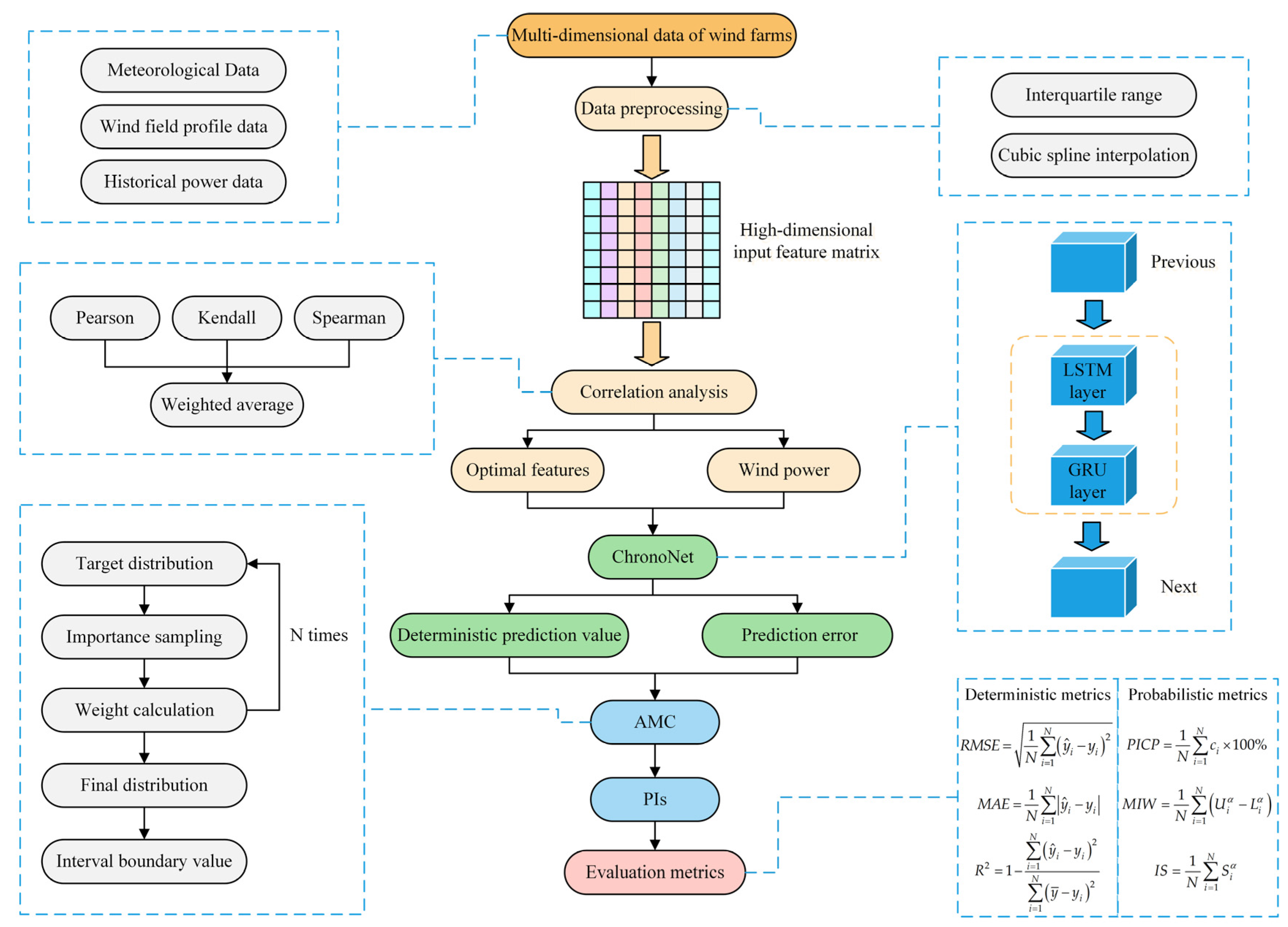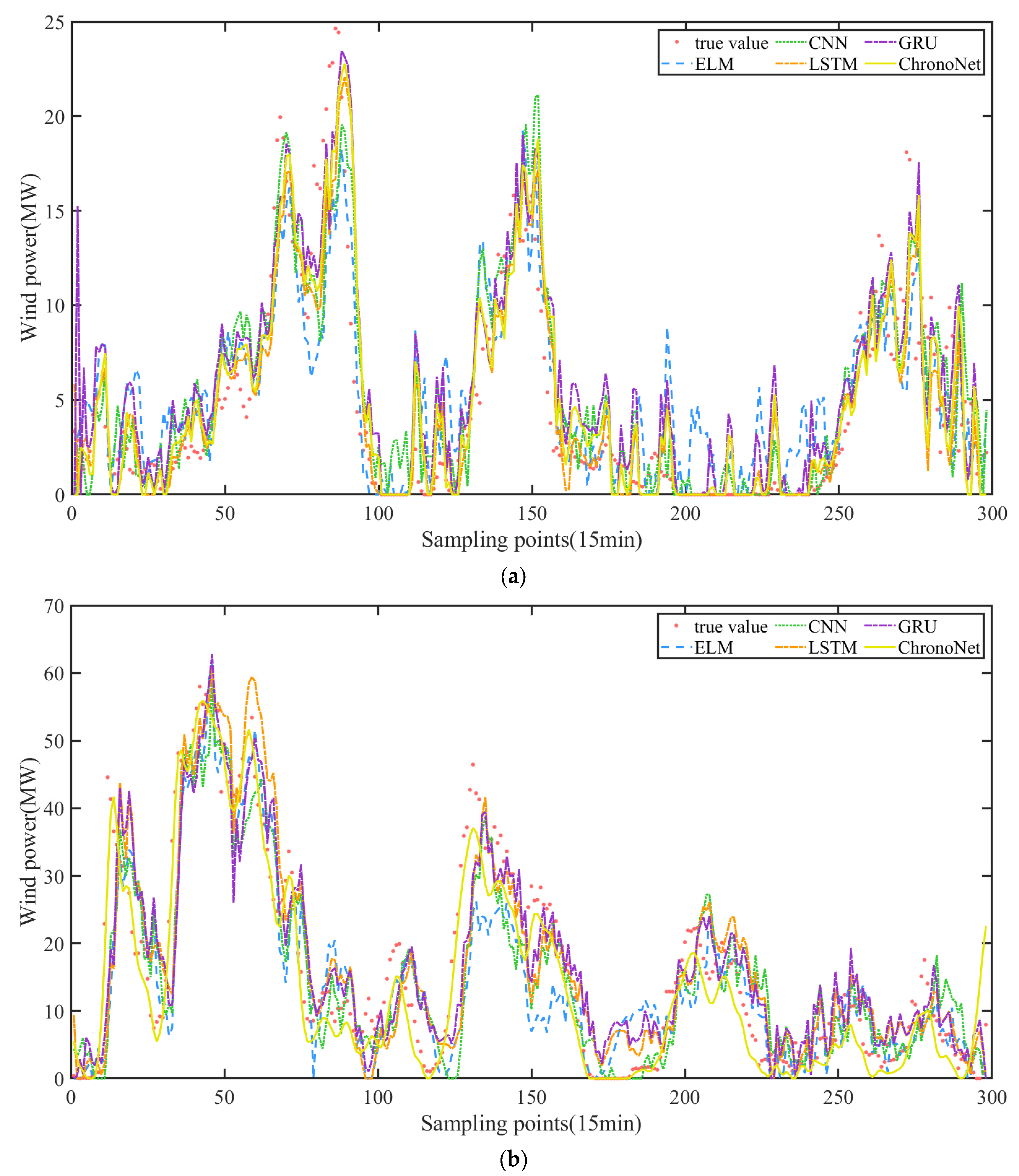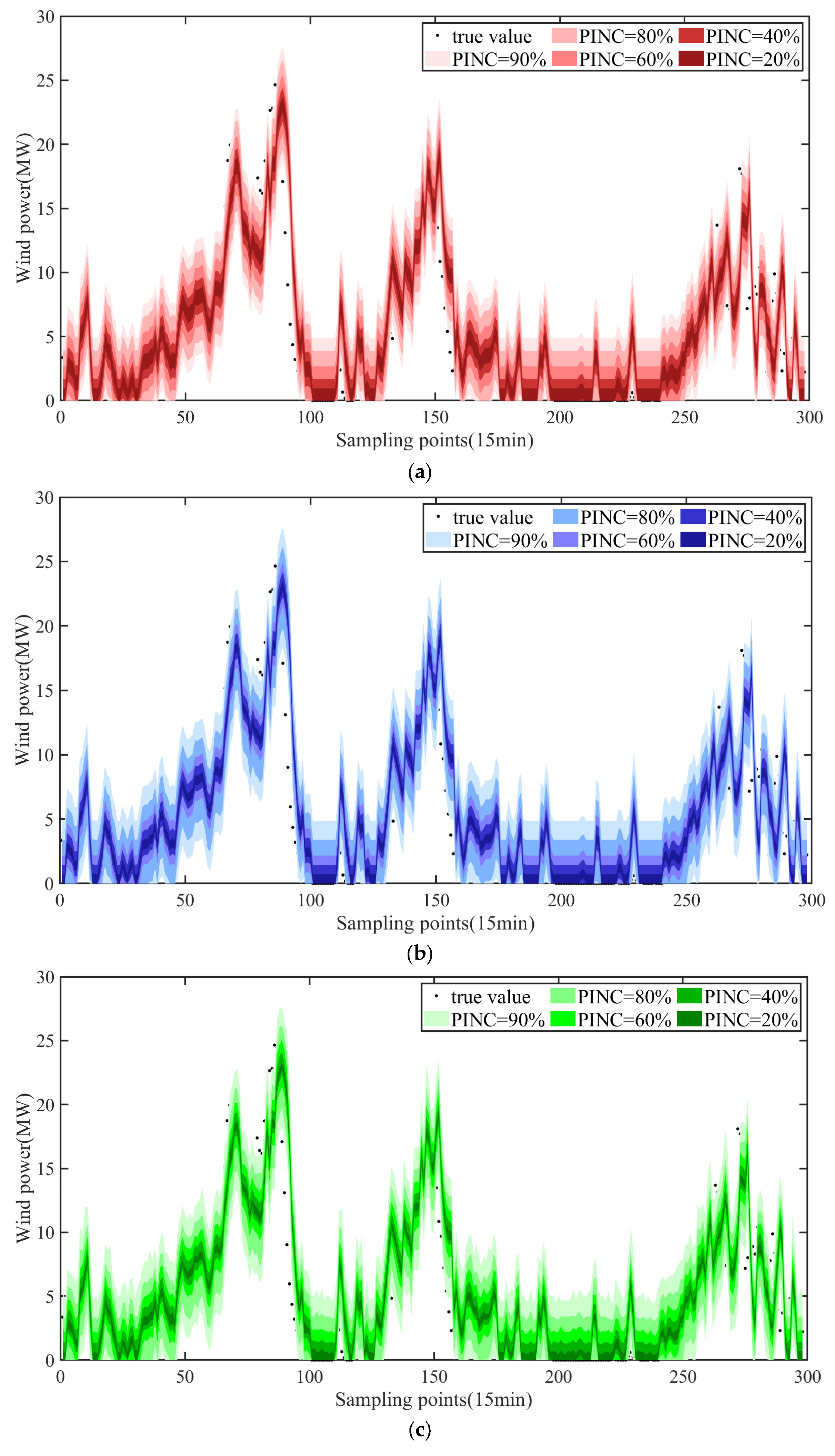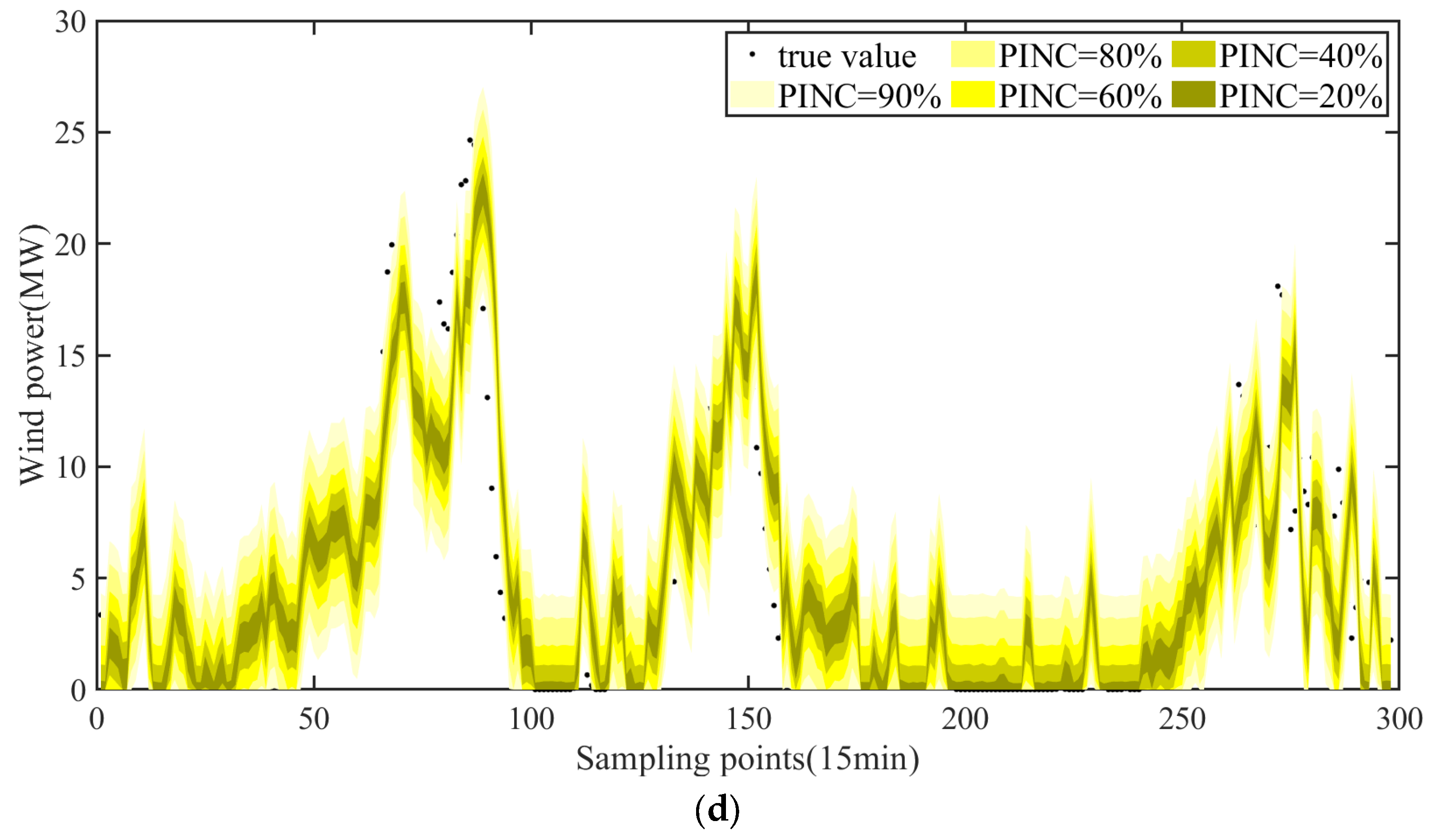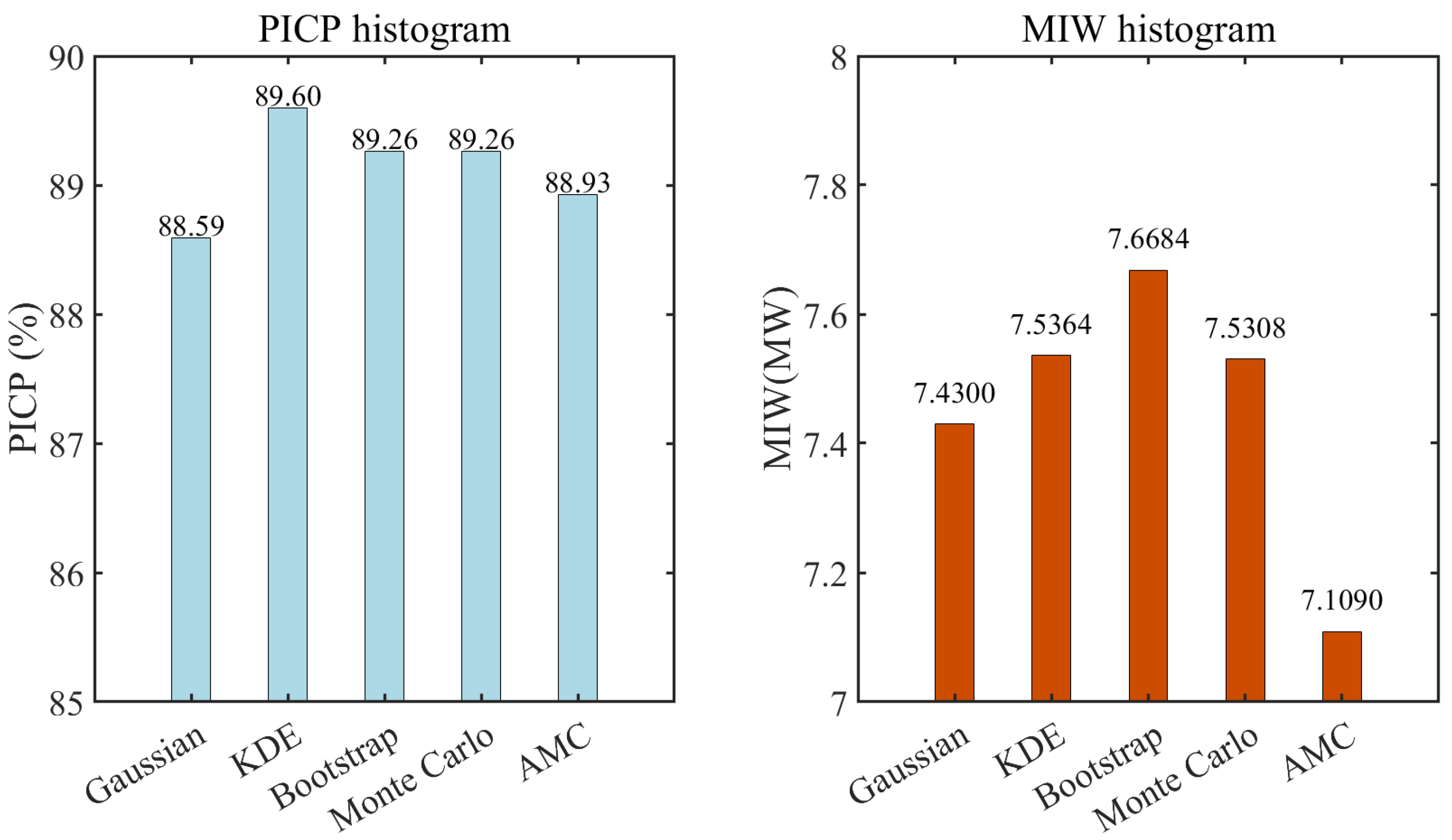1. Introduction
With the acceleration of global energy transformation, wind power has gained widespread application [
1,
2]. However, despite the significant environmental benefits of wind power, its variable characteristics threaten the dependability of electrical grids. Therefore, accurately predicting fluctuations in wind power, especially for ultra-short-term forecasts, has become a key research topic to improve the efficiency of grid dispatching [
3,
4].
Deterministic and probabilistic forecasting are the predominant approaches in wind power prediction. Deterministic prediction models are used for numerical prediction, typically by combining historical data with meteorological models [
5,
6]. A method for short-term wind power prediction based on causal regularization combined with an extreme learning machine (ELM) was proposed in [
7], where the ELM was modeled as a structural causal model, and causal regularization terms were introduced to improve the generalization ability of the model. The convolutional neural network (CNN)–long short-term memory (LSTM)–attention mechanism model was proposed in [
8], where supervisory control and data acquisition were used to predict offshore wind turbine power. Time-step parameterization and sensor sensitivity analysis were incorporated to improve offshore wind power forecasting and offer assistance for wind turbine operation and maintenance. A low-carbon economic dispatch strategy was introduced in [
9], which utilized a gated recurrent unit (GRU). Subsequently, a thermal–electric integrated demand response model was established to adjust the thermal–electric demand ratio, further lowering carbon emissions and expenses in the system.
Although existing models have improved prediction accuracy, there are still some limitations in capturing long-term dependencies in certain cases [
10]. For example, while LSTM and GRUs are powerful, these methods still face issues like gradient problems and insufficient adaptability when the time steps are very long due to their fixed gating mechanisms [
8,
9]. The multiple-gated structure and adaptive mechanism were adopted by ChronoNet, which can better capture dynamic dependencies in complex time series and gradually optimize the prediction process based on different features of the data. This not only helps improve model stability but also avoids the modeling difficulties of traditional models on complex data.
Deterministic forecasting methods can provide a single predicted power value, but they fail to accurately reflect the uncertainty of wind power [
11]. In contrast, probabilistic forecasting provides a probability distribution, thus offering more comprehensive decision support [
12,
13]. Modeling error roughness is addressed in [
14] by combining historical wind power features, deep belief network feature extraction, and particle swarm optimization algorithms to analyze error time dependence and achieve error correction in ultra-short-term conditional probabilistic wind power prediction models. A multi-output deep neural network was designed in [
15], where all quantile estimates were output in a single training process, simplifying the structural complexity of traditional quantile regression (QR) models. The marginal probability density function of a wind farm was generated in [
16] using kernel density estimation (KDE), where the KDE bandwidth was optimized, and the golden section search algorithm was employed to reliably predict the power generation for the following day using only three months of historical data. A probabilistic forecasting model was proposed in [
17], where the time series was divided into intervals based on error information, and Bootstrap was used to estimate error confidence intervals, overcoming the randomness and instability of seasonal load data by using the interval prediction method.
Among various probabilistic forecasting methods, the Monte Carlo (MC) method can estimate more accurate probabilistic distributions by randomly simulating a large number of samples [
18]. A model based on NWP wind speed and MC method was presented in [
19], where hierarchical clustering and empirical distribution fitting were used to forecast power fluctuation intervals, and the reliability of the method was verified. It is important to emphasize that the implementation of MC is based on a static model, which means assuming that the relationship between variables is fixed. However, in practical applications, meteorological conditions, environmental factors, and other variables exhibit significant dynamic changes, making the MC method insufficient to adapt to the probability distribution of forecasting errors. To improve efficiency and accuracy, an AMC method is introduced in this paper, which dynamically adjusts the sampling strategy based on the current simulation results to optimize the sample distribution.
Wind power variations are shaped by not just weather conditions, but also by elements like seasonal shifts, terrain, and past power generation data [
20]. In reference [
21], various environmental factors were integrated, and the features with the highest correlation coefficients were input into the model, validating the effectiveness of the model. The day-ahead joint forecasting method was proposed in [
22] by extracting key meteorological factors and integrating deep learning models. However, although existing studies focus on the correlation between wind power features, they typically rely on a single data source, and the analysis methods are inflexible, unable to effectively adapt to the characteristics of different data [
23]. Therefore, a Multfusion method, integrating multiple data sources, can overcome the limitations of traditional data.
In view of the above issues, a MultiFusion–ChronoNet–AMC-based wind power probabilistic hybrid forecasting model is presented. Firstly, the combination of interquartile range (IQR), cubic spline, and correlation analysis are used to achieve MultiFusion, enhancing the integrity and correlation of the data. Subsequently, through the concatenation of LSTM and GRUs, the ChronoNet multiple-gated network is constructed to obtain deterministic prediction values. Finally, the AMC method is employed to generate adaptive prediction intervals (PIs) under different confidence levels, quantifying the volatility range of wind power. Compared with traditional forecasting models, the main contributions of this paper are as follows:
- (1)
MultiFusion is studied to effectively integrate data from different sources through data preprocessing methods and correlation analysis, overcoming issues of data missingness and low-quality data.
- (2)
A new model, ChronoNet, is proposed, which balances both long-term and short-term dependencies in time series, enhancing the model’s ability to capture complex time-series data.
- (3)
The proposed AMC method can adapt the sampling strategy established on the already sampled data, providing more reliable PIs.
The rest of this paper is organized as follows:
Section 2 establishes the theoretical structure;
Section 3 introduces the dataset and evaluation metrics;
Section 4 analyzes the results; and
Section 5 summarizes the paper.
4. Case Studies
4.1. Multi-Source Data Fusion Results
The reason why the deterministic prediction model achieves good predictive performance is that it integrates MultiFusion method. The utilization of model resources is optimized by MultiFusion, enabling the model to capture the complex nonlinear and spatiotemporal relationships in the data. Therefore, it is necessary to conduct an analysis of multi-source data fusion.
The results of summer wind power processing are shown in
Figure 4. As can be seen, the cleaned power curve not only fills in the missing data but also smooths the data, effectively eliminating unreasonable fluctuations caused by data noise or faults, while maintaining the continuity and physical plausibility of the data.
To identify the most relevant features for wind power, a correlation analysis of various features of the wind farm is performed. Pearson, Kendall, and Spearman correlation coefficients are used to study the relationships between different features of the wind farm, and the analysis results are shown in
Figure 5. It is clearly observed that meteorological and wind direction data have a weaker correlation with power, while wind speed data shows a stronger correlation with power.
Table 1 lists the variable names corresponding to various symbols.
To investigate the correlation of wind speed at different profiles,
Table 2 provides detailed numerical values. From the “Average” column, it can be observed that the wind speed correlation follows this order: Upper level > Middle level > Lower level > Ground level. Therefore, the Upper-level wind speed is selected as the optimal wind power feature.
4.2. Deterministic Forecasting Analysis
This study selects a series of representative benchmark models, including ELM, CNN, LSTM, GRU, BiLSTM, etc., for comparison with the proposed model. The prediction time scale is ultra-short-term, and the parameter configurations for different models are shown in
Table 3.
Based on the above parameter settings, the rolling prediction method is adopted in this paper to make deterministic predictions for wind power output one hour in advance, with the results shown in
Figure 6.
Firstly, although the ELM can capture the basic trend of wind power output, its predictions exhibit significant fluctuations, indicating limitations in handling the complexity and periodicity of wind power output. The CNN, while sensitive to the extraction of local features, is less effective in capturing the periodicity and regularity of long time series, resulting in relatively rough predictions. LSTM can better capture the long-term dependencies in time-series data, but it still shows some bias when dealing with complex wind power data, especially during periods of high volatility. In contrast, the GRU, although similar to LSTM in capturing time-series regularities, performs slightly worse than LSTM in some complex fluctuations, particularly in long-term predictions. The ChronoNet hybrid model, by combining the strengths of both, can more effectively capture the regularity and volatility of wind power output, showing a significant improvement in prediction accuracy, especially during high-volatility and complex patterns. It can maintain smoothness while accurately reflecting the fluctuation characteristics of wind power.
The deterministic forecasting error metrics of the different models are shown in
Table 4. Among these metrics, a lower RMSE and MAE indicate smaller prediction errors and better performance, while a higher R
2 reflects better forecasting performance. As seen from the table, during winter, the ChronoNet model reduces the RMSE by 0.6396 MW, 0.2103 MW, 0.1918 MW, 0.1861 MW, and 0.0813 MW compared to the ELM, CNN, LSTM, GRU, and BiLSTM, respectively. The MAE is reduced by 0.6324 MW, 0.2039 MW, 0.1117 MW, 0.1817 MW, and 0.0956 MW, respectively. R
2 is increased by 0.1037, 0.0311, 0.0282, 0.0273, and 0.0144, respectively. In summer, the ChronoNet model reduces the RMSE by 3.4345 MW, 2.36 MW, 2.7892 MW, 2.2011 MW, and 1.0873 MW compared to the ELM, CNN, LSTM, GRU, and BiLSTM, respectively. The MAE is reduced by 2.2253 MW, 1.4346 MW, 1.8894 MW, 1.5125 MW, and 0.7684 MW, respectively. R
2 increases by 0.1526, 0.0938, 0.1161, 0.0859, and 0.036, respectively. Therefore, the ChronoNet model demonstrates a significant advantage in wind power output forecasting, showing stronger adaptability and higher forecasting accuracy.
4.3. Probabilistic Forecasting Analysis
The ChronoNet hybrid model can provide accurate deterministic predictions in time-series forecasting. However, in practical applications, the forecast results are often accompanied by uncertainty. Therefore, incorporating probabilistic forecasting analysis can better quantify and assess the uncertainty of predictions, providing decision-makers with more reliable prediction intervals and risk assessments. The probabilistic forecasting results of benchmark methods such as Gaussian distribution, KDE, and Bootstrap resampling are given using winter data as an example. The probabilistic forecasting results of different methods are shown in
Figure 7.
Figure 8 presents the probabilistic prediction metrics for different prediction methods, with PINC = 90% as an example. Specifically, PICP is used to measure the proportion of true values falling within PIs, with higher values indicating better performance. MIW is used to measure the width of the PIs, and smaller MIW values generally suggest more precise predictions. From
Figure 8, it can be observed that the difference between the PICP and PINC values of the listed probabilistic forecasting methods is within 2%, indicating that the coverage rates of the various methods are relatively stable and meet the requirements of the given PINC. The advantage of AMC is that its PICP is higher than that of Gaussian distribution, and its MIW is significantly smaller than other methods, reflecting the ability of AMC to effectively model the data distribution and generate more accurate predictions.
To further analyze the probabilistic forecasting performance of different models, the comprehensive metric IS in
Table 5 provides a clear quantitative standard for model performance under different PINC conditions. Specifically, a higher IS represents better overall performance. Compared to the Gaussian, KDE, Bootstrap, and MC methods, at PINC = 20%, the IS of AMC improves by 0.6591, 0.6768, 0.6515, and 0.6899, respectively; at PINC = 40%, the IS of AMC improves by 0.5699, 0.788, 0.8199, and 0.5813; at PINC = 60%, the IS of AMC improves by 0.3938, 0.6629, 0.6369, and 0.4006; at PINC = 80%, the IS of AMC improves by 0.1753, 0.202, 0.1953, and 0.1795; and at PINC = 90%, the IS of AMC improves by 0.1114, 0.0666, 0.0755, and 0.1082.
This result shows that, under different PINC conditions, the AMC method achieves the best IS values. This indicates that AMC method demonstrates strong stability and accuracy in probabilistic forecasting, making it capable of handling complex probabilistic models.
To further compare the effectiveness of the AMC method under different deterministic prediction models,
Table 6 presents the probabilistic prediction metrics for CNN-LSTM and ChronoNet. In
Table 6, the IS of ChronoNet is higher than that of CNN-LSTM under different PINC values, validating the ChronoNet model proposed in this paper is better suited for AMC method.
Additionally, it can be seen that AMC method can better approximate the true probability distribution in the probabilistic prediction process, thereby maintaining stable and efficient performance under various PINC conditions. Therefore, the model proposed in this paper has demonstrated strong adaptability and superiority in probabilistic forecasting tasks, providing strong support for model selection.
5. Conclusions
A MultiFusion–ChronoNet–AMC-based wind power ultra-short-term probabilistic forecasting model is proposed, which can fully demonstrate the advantages of integrating multi-dimensional information and deep learning technologies in modern wind power forecasting. MultiFusion effectively improves the prediction accuracy and robustness of the model by combining meteorological data, geographic information, historical power, and other information, overcoming the limitations of traditional data. The ChronoNet further enhances the model’s ability to handle long-term time-series dependencies and dynamic features. Compared to the traditional LSTM and GRU models, it is better at capturing the complex variation patterns of wind power.
Additionally, compared to the Gaussian distribution, KDE, Bootstrap, and MC methods, the AMC method is more flexible in adapting to nonlinear and high-dimensional complex scenarios, generating more accurate probability distributions and providing more reliable PIs.
In summary, the model proposed in this paper demonstrates stronger adaptability, accuracy, and reliability in wind power forecasting, offering a more efficient decision-support tool for the wind power industry. Future research will focus on ensemble learning and conditional probabilistic prediction of wind farm cluster power, providing strong support for intelligent decision making in the wind energy sector.
